Double-decker buses, Buckingham Palace and London Bridge, London landmarks are straight from a Monopoly board. With so many landmarks in London to see, it can be exciting and overwhelming. England’s dynamic capital is jam-packed with historical and modern-day attractions, from churches and cathedrals to castles and mansions to theatres, museums, quirky streets and markets. Although there are plenty of places in England to tick off your bucket list, London is such a big city with so many distractions, there are enough London landmarks to keep you busy for weeks.
Contents
- 35 Incredible London Landmarks
- Plan Your Trip
- Famous London Landmarks
- 1- Buckingham Palace
- 2- Westminster Abbey
- 3- Big Ben
- 4- Houses of Parliament
- 5- Tower of London
- 6- Royal Albert Hall
- 7- Natural History Museum
- 8- HMS Belfast
- 9- The British Museum
- 10- Royal Museums Greenwich
- 11- The Eros Statue in Piccadilly Circus
- 12- Harrods
- 13- Tower Bridge
- 14- St Paul’s Cathedral
- 15- Trafalgar Square
- 16- Covent Garden
- 17- Kensington Palace
- 18- Kew Gardens
- 19- London Transport Museum
- 20- Hampton Court Palace
- 21- The London Telephone Box
- Modern Landmarks in London
- London Landmarks in Southbank
35 Incredible London Landmarks
Plan Your Trip
- Airport transfers: Book an express train transfer from Heathrow and Stansted or a bus from Gatwick, Luton, Stansted or Heathrow. A more convenient way to travel between the airports and your accommodation is to book a shuttle.
- Where to stay: Research accommodation options in London on booking.com.
- eSims: It’s a great idea to get one with ample data as Google Maps is very useful. Choose an eSIM plan here.
- Book tickets in advance: Many popular attractions are booked out and you will need to purchase tickets in advance. A convenient way to do this easily online is through Klook or GetYourGuide. If you’re planning to visit a few landmarks, you can save money by getting the London Pass®, which will give you access to 90+ attractions and tours.
Famous London Landmarks
If you’ve never been to London, before doing anything else, here are some famous London landmarks you’ll want to tick off your list.
1- Buckingham Palace
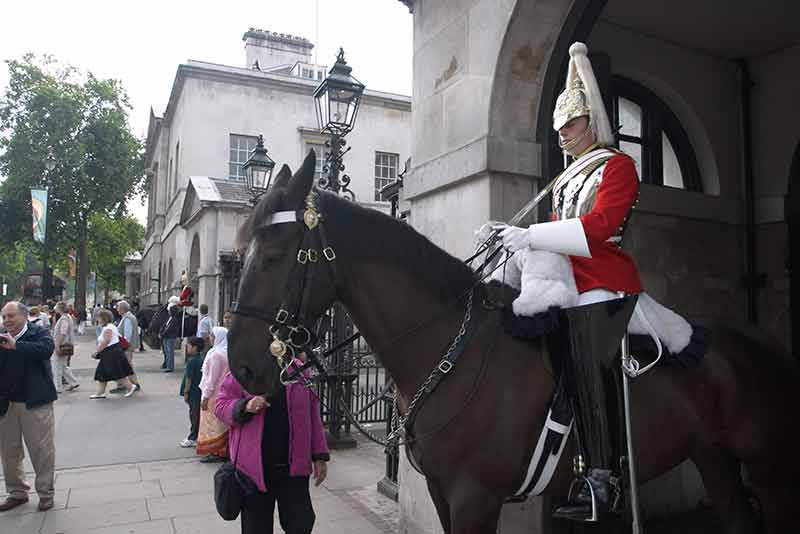
Of all the royal palaces in London, Buckingham Palace is a hub of the British Royal Empire and a drawcard for anyone visiting the nation’s capital.
The London residence of the Queen, Buckingham Palace became the centre of court during the rule of Queen Victoria in 1837 and has been home to the Kings and Queens of England ever since.
From its grand architecture to the colourful palace guards parading through the grounds, Buckingham Palace attracts royal watchers in droves.
Queen Elizabeth II and The Duke of Edinburgh occupy private apartments in the Palace’s north side while the staff use the south wing.
Your chance of seeing the Queen’s private quarters is next to zero but these sections of Buckingham Palace that are open to the public:
- 19 State Rooms are accessible in summer for 10 weeks and on specific dates in spring and winter.
- The Royal Mews (open between February and November) has a dazzling display of royal coaches and carriages and a working stable. It’s home to the Gold State Coach, which has been used at every coronation since that of George IV in 1821.
- Queen’s Gallery to see items displayed from the Royal Collection, such as paintings, rare furniture and collections of photographs.
Buckingham Palace is at Westminster, London.
2- Westminster Abbey
Most people will recall seeing the Gothic architecture of Westminster Abbey on TV.
16 royal weddings have occurred in Westminster Abbey, most recently the Duke and Duchess of Cambridge (William and Kate) in April 2011.
Westminster Abbey is also where coronations have been held since 1066, and here 17 monarchs are buried.
Founded by Benedictine monks in 960AD, the Abbey continues to serve as a place of worship and attending a service is an iconic thing to do.
Other things to do at Westminster Abbey include visiting the Royal Tombs, where 30 kings and queens are buried, starting with Edward the Confessor.
The Coronation Chair has been used during coronations since 1308 and was initially commissioned by King Edward I to enclose the Stone of Scone, which was transported from Scotland in 1296.
Westminster Abbey is at The Chapter Office, Westminster Abbey, 20 Dean’s Yard, London.
3- Big Ben
The Houses of Parliament and its famous Big Ben, the most prominent and highest clock tower in the United Kingdom, is an iconic London landmark recognised around the world.
Although the term “Big Ben” is generally used to describe the clock, tower and bell, the name was initially meant for the Great Bell.
The Great Bell sounded for the very first time on 11 July 1859 and is housed in Elizabeth Tower at the northern end of the Houses of Parliament.
The Clock Tower was constructed with materials from across the country, such as Cornish granite and Yorkshire Anston stone.
According to two theories, Big Ben was either named after Sir Benjamin Hall, First Commissioner for Works, or champion heavyweight boxer Ben Caunt.
Which do you think is more likely?
Big Ben is at Westminster, London.
4- Houses of Parliament
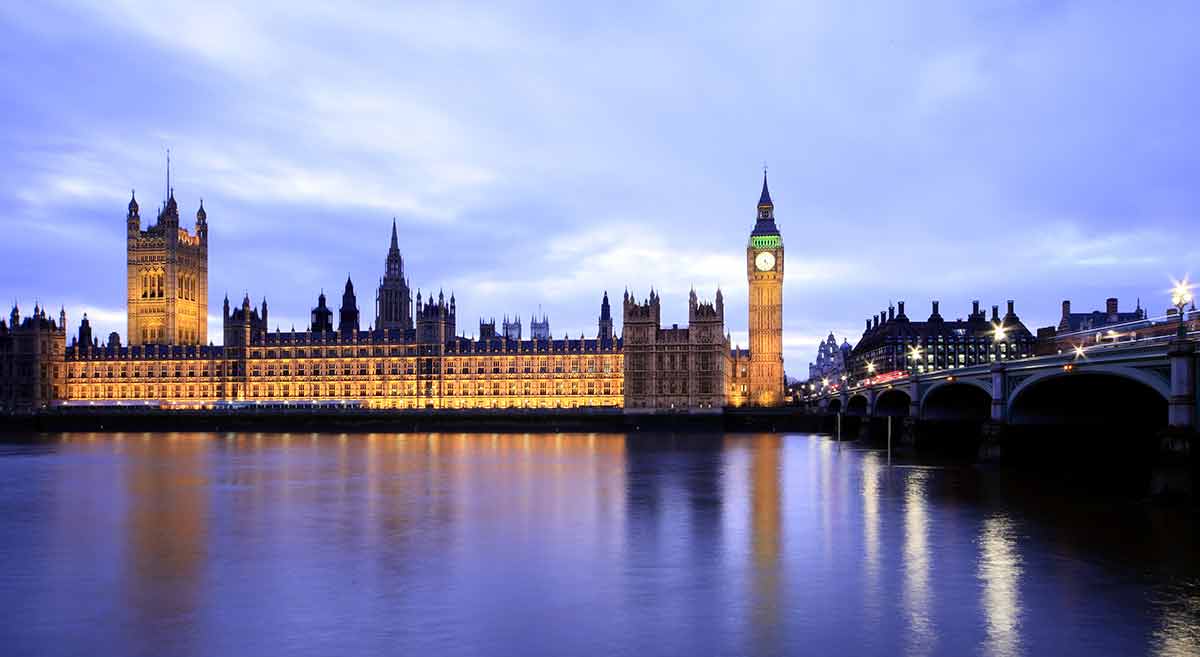
The Palace of Westminster is the seat of power in modern-day London.
Located next to Big Ben, it is also known as the Houses of Parliament as this is where the representatives of the Houses of Commons and Lords meet to debate issues.
The beautiful buildings sit on hallowed ground where the palace of King Canute once stood.
The oldest section of the estate is Westminster Hall, which has been part of history in Britain for 900 years.
Architect Charles Barry redesigned the building after the Great Fire of 1834, and the Commons Chamber was damaged during WWII.
There’s lots of history to explore, and you could spend all day at the Houses of Parliament.
The Palace of Westminster is on the left bank of the Thames.
5- Tower of London
Take a step back into British history by visiting the Tower of London, which has been a royal palace, an arsenal and garrison, a zoo for the royal family and a jewel house.
Don’t miss the Crown Jewels exhibition of 23,578 gemstones, and a Yeoman Warder tour will reveal gruesome tales of intrigue, execution and torture.
Tower traditions include the ceremonial locking and unlocking of the fortress gates known as The Ceremony of the Keys and Gun Salutes.
The Beating of the Bounds is where children and officials beat the stones around the tower with willow wands, following an ancient custom to reaffirm boundaries.
The Tower of London is at St Katharine’s & Wapping, London.
6- Royal Albert Hall
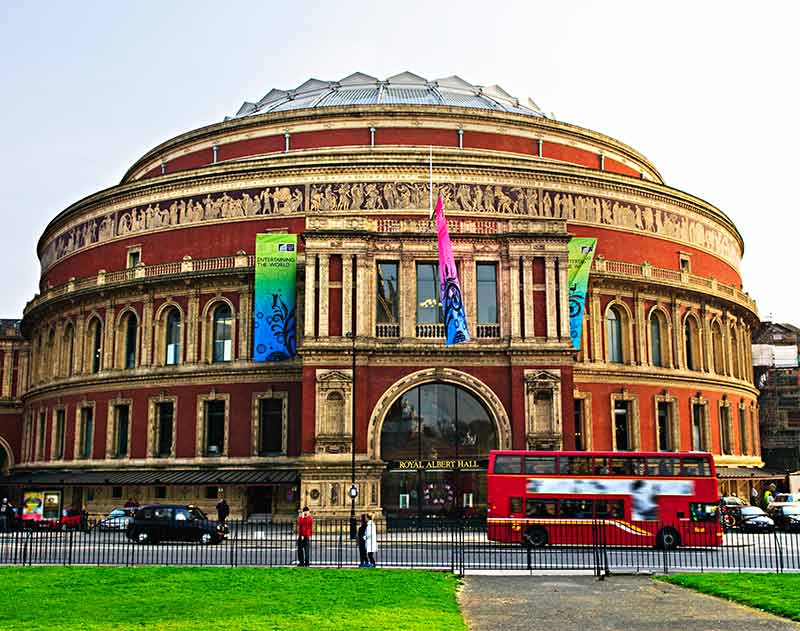
Royal Albert Hall is a distinctive building opened in 1871 by Queen Victoria and named after Prince Albert.
The hall is a venue for concerts, pop and classical, sporting events, festivals and gala balls.
It can seat over 5,000 people and is home to the famous annual proms Royal Philharmonic Orchestra.
The famous Royal Retiring Room is a walk down memory lane, with portraits of the Royal Family and decorated with sumptuous Victorian furnishings.
The Queen has a private suite and box at the Royal Albert Hall.
Royal Albert Hall is at Kensington Gore, South Kensington, London.
7- Natural History Museum
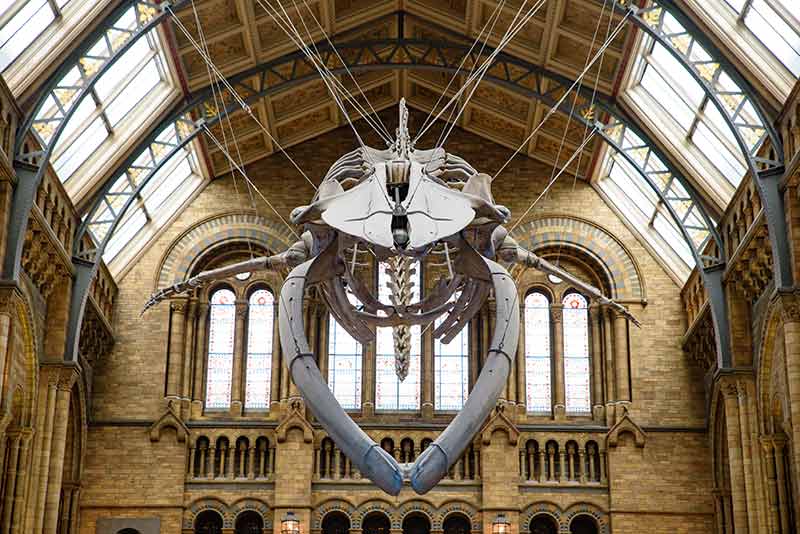
London’s Natural History Museum has a vast collection of exhibits and specimens that document the natural world.
One of the most popular galleries is the Dinosaurs gallery, which has a Diplodocus skeleton on display.
Wander around the museum to see hundreds of specimens, watch scientists at work in their laboratories and join experts at the Darwin Centre’s Attenborough Studio to learn the secrets of science and nature.
The Natural History Museum is at Cromwell Rd, South Kensington, London. Skip the lines and book your tickets here.
8- HMS Belfast
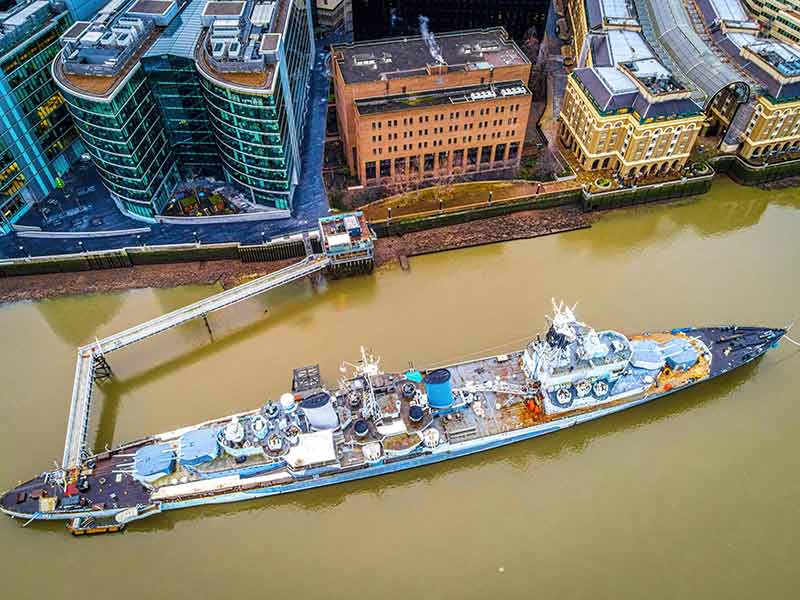
HMS Belfast is the most famous Royal Navy warship from WWII.
The ship has a distinguished history, firing some of the first shots during the D-Day landings and served in the Korean War.
Its nine decks are a fascinating museum accessed by ladders and hatches.
Start at the quarter-deck, which has displays of WWII, the end of the Empire and the Cold War.
The former warship is moored on the River Thames, and the quarter-deck has a fantastic view of Tower Bridge.
Another corner to explore is the 6-inch gun turret, which is kitted out with an immersive sound installation that communicates the D-Day event that happened at 05.27 on 6 June 1944 when HMS Belfast fired on Normandy’s beaches.
HMS Belfast is at The Queen’s Walk, London.
9- The British Museum
London’s British Museum is packed with curated exhibitions of artefacts from around the world documenting human history, culture and art.
The museum is over two centuries old and is within a building designed in the Greek Revival style by Sir Robert Smirke.
The British Museum’s impressive collection of eight million works is one of the largest in the world.
Its 60 galleries span the entire history of the world.
Some highlights are the Egyptian Gallery, which documents 3,000 years of Egyptian history, including the Rosetta Stone, and the rise and fall of the Roman Empire in Room 70.
The British Museum is at Great Russell St, London.
10- Royal Museums Greenwich
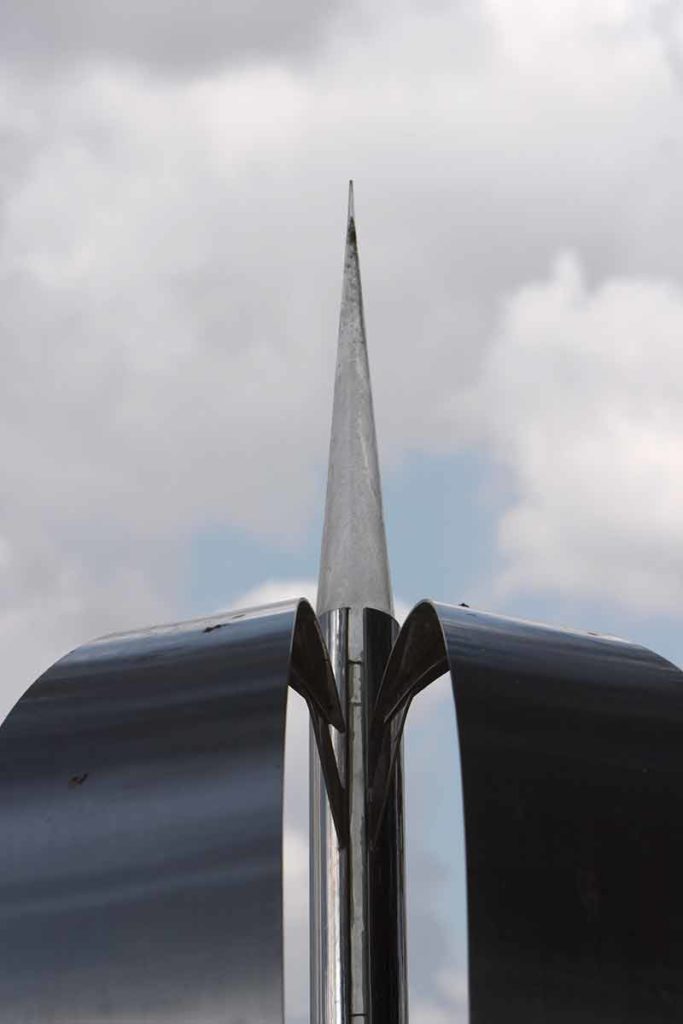
Royal Museums Greenwich is home to the National Maritime Museum, the Cutty Sark, the Royal Observatory and the Queen’s House art gallery.
The four museums form a UNESCO World Heritage site that is a reminder of Britain’s supremacy during the prime of the British Empire and a place to learn about maritime history.
A fun thing to do is to straddle the Prime Meridian of the World, which signifies Greenwich Mean Time (GMT).
It’s the line that divides the eastern and western hemispheres of the earth.
Royal Museums Greenwich is at Blackheath Ave, Greenwich, London.
For more amazing European Landmarks, read:
- 30 Spain Landmarks
- 20 Switzerland Landmarks
- 22 Germany Landmarks
- 35 London Landmarks
- 30 France Landmarks
- 20 Italy Landmarks
- 20 Greece Landmarks
- 20 Russia Landmarks
- 20 Scotland Landmarks
- 20 Ireland Landmarks
- 21 Wales Landmarks
- 20 Turkey Landmarks
- 20 England Landmarks
- 20 Hungary Landmarks
- 21 Romania Landmarks
- 20 Ukraine Landmarks
- 20 Athens Landmarks
- 20 Rome Landmarks
- 20 England Landmarks
- 20 Portugal Landmarks
- 20 Poland Landmarks
- 20 Iceland Landmarks
- 20 Bulgaria Landmarks
- 21 Croatia Landmarks
- 20 Bulgaria Landmarks
- 20 Austria Landmarks
- 21 Finland Landmarks
- 20 Sweden Landmarks
- 20 Denmark Landmarks
- 20 Belgium Landmarks
- 20 Netherlands Landmarks
- 20 Barcelona Landmarks
- 21 Czech Republic Landmarks
- 20 Landmarks in Paris
- 20 Landmarks in Liverpool
- 10 Istanbul Landmarks
11- The Eros Statue in Piccadilly Circus
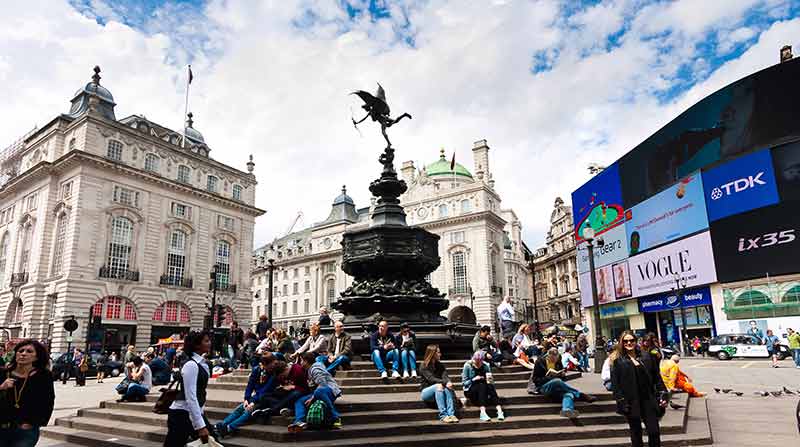
Piccadilly Circus is the entertainment district of London and has enough giant electronic advertisements boards to rival New York’s Time Square.
This famous London tourist destination has plenty of cinemas, theatres, bars, clubs and restaurants.
The statue of a winged archer in a pose with his bow sits atop the Shaftesbury Memorial Fountain, which is an instantly recognisable meeting point.
The 19th-century statue commemorated the philanthropic work of Lord Shaftesbury and was designed by Sir Alfred Gilbert in the image of Anteros (Eros’ brother).
12- Harrods
Looking for fancy and fashionable attire? Want to learn how to dress like an English gent or lady?
Harrods, the famous department store, is a showcase of seven floors with 330 departments, 32 restaurants, a bank and a world-famous food hall.
First-time visitors to London will enjoy visiting this establishment that grew from the ground up, dating back to 1873.
By 1883 Harrod’s had grown into a department store with six departments and 200 staff.
The progressive department store had the world’s first moving staircase in 1898, serving brandy to customers who reached the top.
It changed hands a few times and was purchased by Qatar Holdings in 2010 for £1.5bn.
Harrods is at 87-135 Brompton Road, Knightsbridge, London.
13- Tower Bridge
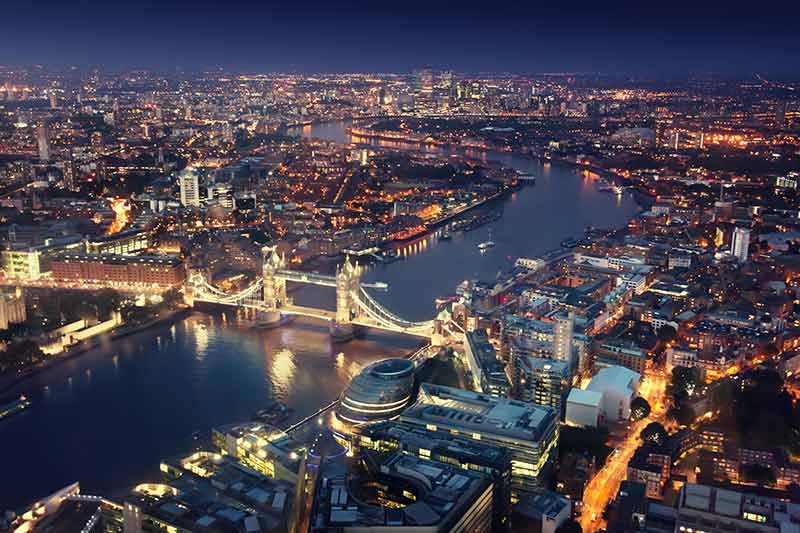
The bridge in the nursery rhyme “London Bridge is falling down” is a London landmark for photographers.
Get an eyeful of Tower Bridge with cars and red double-decker buses as they zoom along the bridge.
For a panoramic shot from a higher vantage point, there are the high-level Walkways and Glass Floor, where you can look down from 42 m above the River Thames. It’s one of the things to do in London at night.
Inside Tower Bridge, you’ll find an exhibition weaved among the historic steam engines and coal burners that once powered the bridge.
In the early years, before it switched to electricity in 1976, Tower Bridge was raised up to 30 times a day.
Tower Bridge is at Tower Bridge Rd, London and is open from 930am to 5 pm.
14- St Paul’s Cathedral
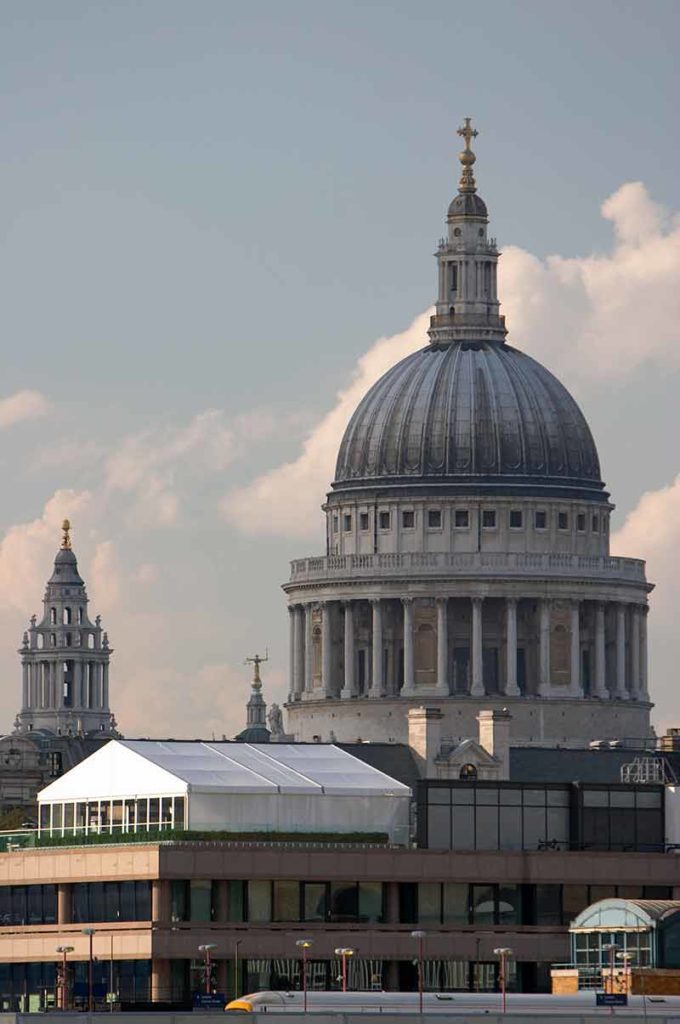
St Paul’s Cathedral, with its grand dome, is an imposing structure in London’s towering skylines.
The beautiful interior of the cathedral is one of the most stunning historic buildings in London and its view of the Thames River is worth a visit.
Climb 528 steps to capture another panoramic picture of riverside London and when you’re satisfied with your photographs from above, pay a visit to The Crypt below.
St Paul’s Cathedral is the main church of the Dioceses of London and a landmark worth visiting at least once.
It has one of the largest cathedral domes in the world and the sound acoustics in the Whispering Gallery is amazing.
The art collection house in St Paul’s Cathedral is impressive and ranges from Madonna and Child by Henry Moore to Victoria period mosaics and modern artworks.
St Paul’s Cathedral is at St. Paul’s Churchyard, London. Skip the lines and order entry tickets here.
15- Trafalgar Square
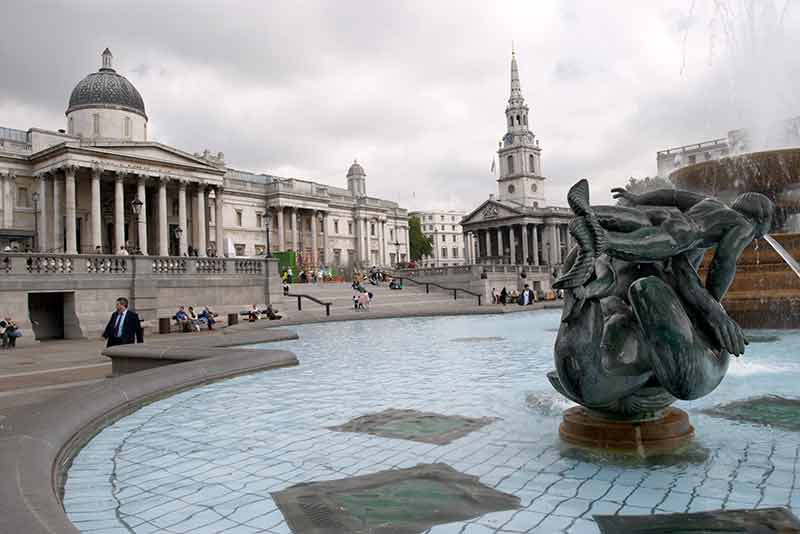
Between the 14th and the 17th centuries, the area that is now Trafalgar Square was the courtyard of the Great Mews stabling of Whitehall Palace.
Conceptualised in 1812, it was redeveloped into a public space and opened in 1830 as Trafalgar Square.
The Nelson memorial statue, two fountains and the bronze lion guarding the base of Nelson’s Column were added at different stages later.
These days, Trafalgar Square is a meeting point in the city centre and a place where events are held. This public square in London attracts both visitors and locals.
16- Covent Garden
Covent Garden is a famous entertainment hub in the West End of London, with a pedestrian piazza, street entertainment, stores and stalls.
It’s also home to the Apple Market and the Royal Opera House.
It’s a great place to spend time in London and home to the 17th-century St. Paul’s Church and London’s famous Transport Museum, which has an impressive collection of vintage vehicles.
The restaurant and theatre precinct also draws visitors to see musicals and plays.
The Covent Garden tube station on the Piccadilly Line is on James Street, close to the Market Building at the end of James Street.
Tip: Covent Garden tube station has 193 steps, so if you don’t want to climb steps get off at Leicester Square or Holborn.
17- Kensington Palace
Kensington Palace was once a small villa called Nottingham House, the country retreat of William III and Mary II.
Initially built in 1689, the palace grew to become a fashionable residence for the British royal families.
Queen Victoria grew up at Kensington Palace before moving to Buckingham Palace in 1837.
Kensington was turned into a residence for minor royals and was where Princess Diana, Princess Margaret and Harry and Megan, the former Duke and Duchess of Sussex, lived.
The Duke and Duchess of Cambridge also live here when they are not in their Sandringham Estate in Norfolk.
Kensington Palace is a short walk from Paddington and Marylebone stations.
18- Kew Gardens
Kew Garden is a UNESCO World Heritage site with over 50,000 plants.
The 18th-century gardens were once part of the royal palace, but these days it’s a world-renown scientific institution for plant and fungal research.
The garden, with its 14,000 trees, is a tranquil escape for all seasons.
The Arboretum surrounds the glasshouses, is a fabulous place to escape to and has over 2,000 species.
Trees in Kew Gardens include the Japanese pagoda tree (Styphnolobium japonicum), the black locust tree (Robinia pseudoacacia) and giant redwoods.
The tallest tree in the garden is as tall as a 13-storey building. The Sequoia sempervirens is a coastal Redwood.
Kew Garden is continually being renovated, and in recent years, 80 dragons were restored in the Great Pagoda, and the Temperate House also reopened.
Kew Gardens is at Kew, Richmond, London.
19- London Transport Museum
The London Transport Museum has displays that document the history of transport in London and one of the hidden gems in London.
Learn fascinating stories about people who travelled within the city of the past 200 years and find out how new and exciting technologies will impact London.
Don’t miss the Hidden London: the Exhibition and discover the secrets of the world’s oldest underground railway.
The exhibition highlights parts of the Tube network that tell the war years’ history, including the Plessey aircraft underground factory with 2,000 staff who worked in two 2.5 mile-long tunnels during the Second World War.
Some carriages and carts on display date back to the 1800s, and there’s information about the wherries and paddle steamers on the River Thames.
The London Transport Museum is at Covent Garden Piazza, London.
20- Hampton Court Palace
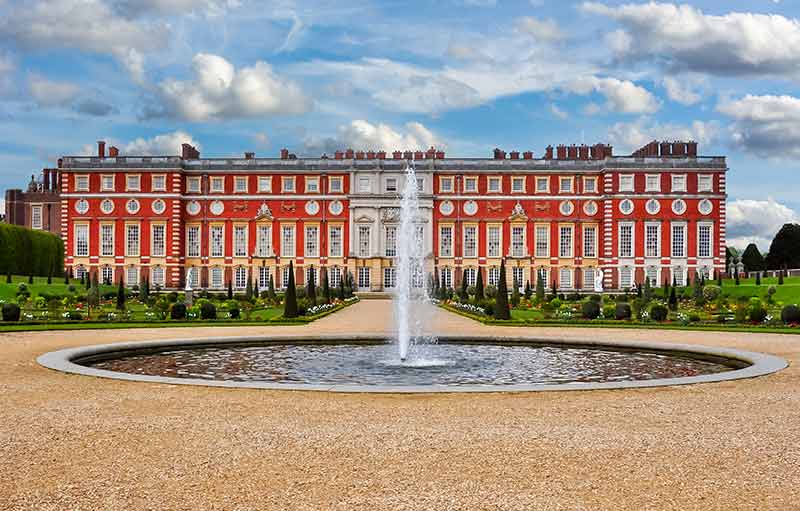
The 16th-century Hampton Court Palace was the home of Henry VIII and his six wives.
Sad memories lurk around the halls of Hampton Court Palace. Henry VIII’s third queen Jane Seymour died here, and her ghost haunts the palace.
The palace has stunning gardens and is famous for its Maze and the Great Vine.
In 1689, William III and Mary II lived here, followed by Georgian royalty and then impoverished aristocrats in 1737.
In 1838, Queen Victoria opened Hampton Court Palace to the public and you can visit the palace as a day trip from London.
Hampton Court Palace is at Hampton Court Palace, East Molesey, Surrey.
21- The London Telephone Box
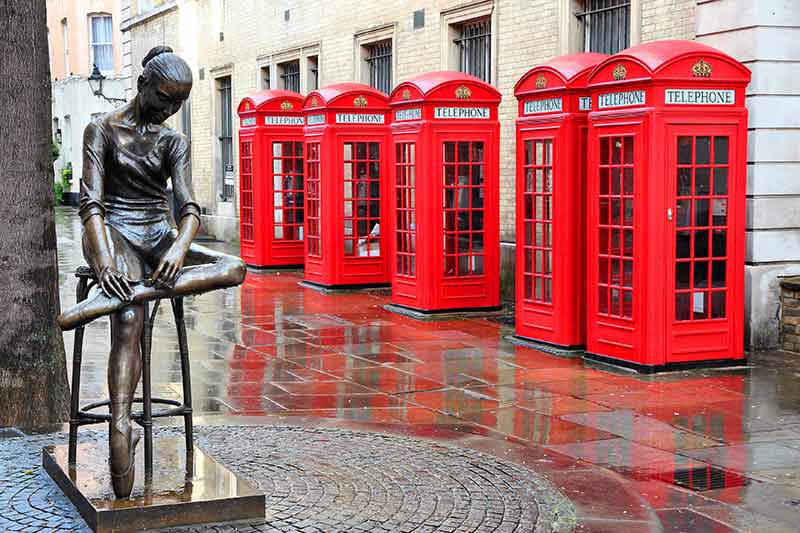
Since creating the traditional British red telephone box, phone boxes spread to the British colonies worldwide and have become a British cultural icon.
The first phone kiosk was produced in 1921 in the UK but the design later evolved into the red phone box that is instantly recognisable.
From 1926, the crown logo was engraved on the fascias of the kiosks to represent the British government.
There are still a few original boxes in the UK and many red phone boxes, which are cheerful landmarks to see in London.
Modern Landmarks in London
22- Out of Order Sculpture
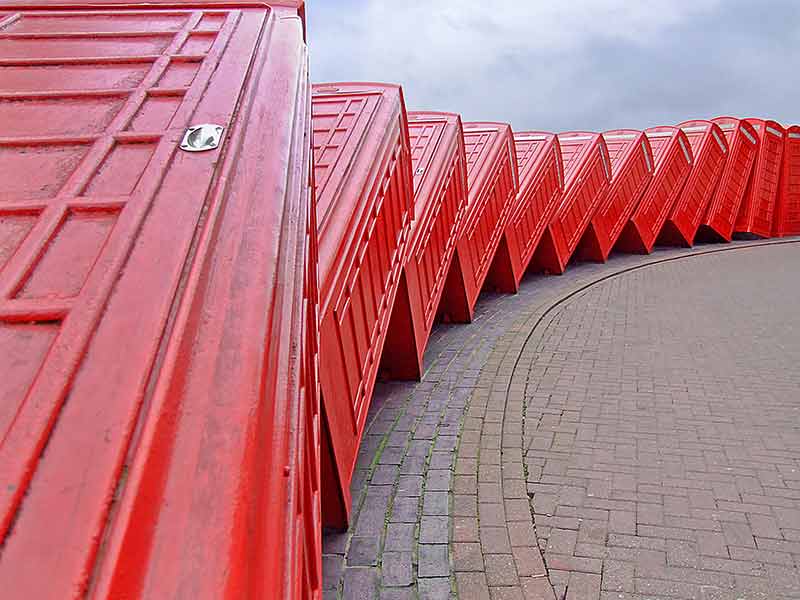
A contemporary twist on the traditional phone box, the Out of Order Sculpture is an installation of 12 telephone boxes toppled over like dominoes.
Created by David Mach in 1989, the public work of art has one red telephone box standing up right and the others leaning against one another tilted at different degrees.
The Out of Order Sculpture is in on Old London Road in Kingston.
23- Thames Barrier
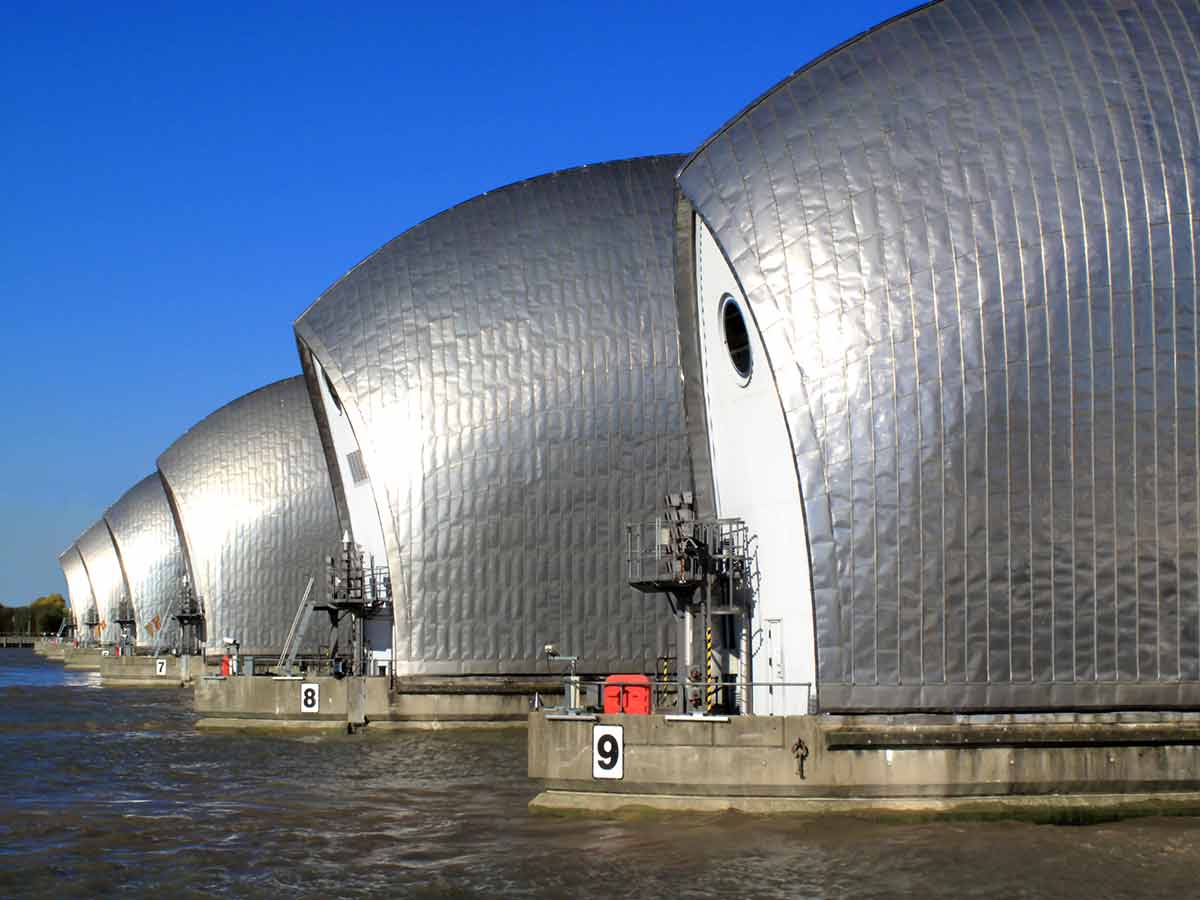
Operated by the Environment Agency, the Thames Barrier is one of the most significant movable flood barriers in the world.
This £500 million barrier is one of London’s flood defences and stretches 520m (1,706ft) across the Thames River.
The Thames Barrier is at Woolwich Reach and has 10 gates used to regulate the water flow in the tidal river to Teddington Lock.
The barrier is used to control flooding, and the Thames Barrier Information Centre offers informative displays about its purpose.
There is also a cafe, a family playground and riverside walkways.
Thames Barrier Information Centre is at 1 Unity Way, London.
24- Millenium Bridge

One of the most striking bridges across the Thames, built in 2000, the Millennium Bridge was the first new bridge over the river for more than 100 years.
The steel suspension bridge has two river piers and uses lateral suspension without tall columns supporting it.
It links Bankside with the City of London for pedestrians.
Millennium Bridge is at Thames Embankment, London.
25- Wembley Stadium
Football fans won’t want to miss joining in the fun at Wembley Stadium.
Get into the spirit and buy an English beer, paint yourself in team colours and wave the team’s banner.
The stadium is Great Britain’s most significant and is where most major sporting events are held.
It has hosted the FIFA championship games, 1948 Olympic Games and the English Cup.
It has 90,000 seats and a circumference of 1km.
Wembley Stadium is at Wembley, London. Join a guided tour of the stadium to find out more.
26- The Shard
The Shard is 300m (1999 ft) high, with 72 floors and London’s best view from the 68th, 69th and 72nd floors.
It towers above the London skyline from Southwark and has offices, restaurants, a hotel, spa and apartments.
A famous Italian architect designed this building, which is the tallest building in London and also the highest skyscraper in Europe.
Renzo Piano was also the creative mind behind the Pompidou Centre in Paris.
The £500m building is in the London Bridge Quarter and has 11,000 glass panels, covering 56,000 square metres (602,779 sq ft) – the size of eight football pitches – and incredible bird’s-eye views.
Shangri-La Hotel occupies floors 34 to 52 of the Shard and rooms have fantastic views too.
The Shard is at 32 London Bridge Steet, London.
27- The Gherkin
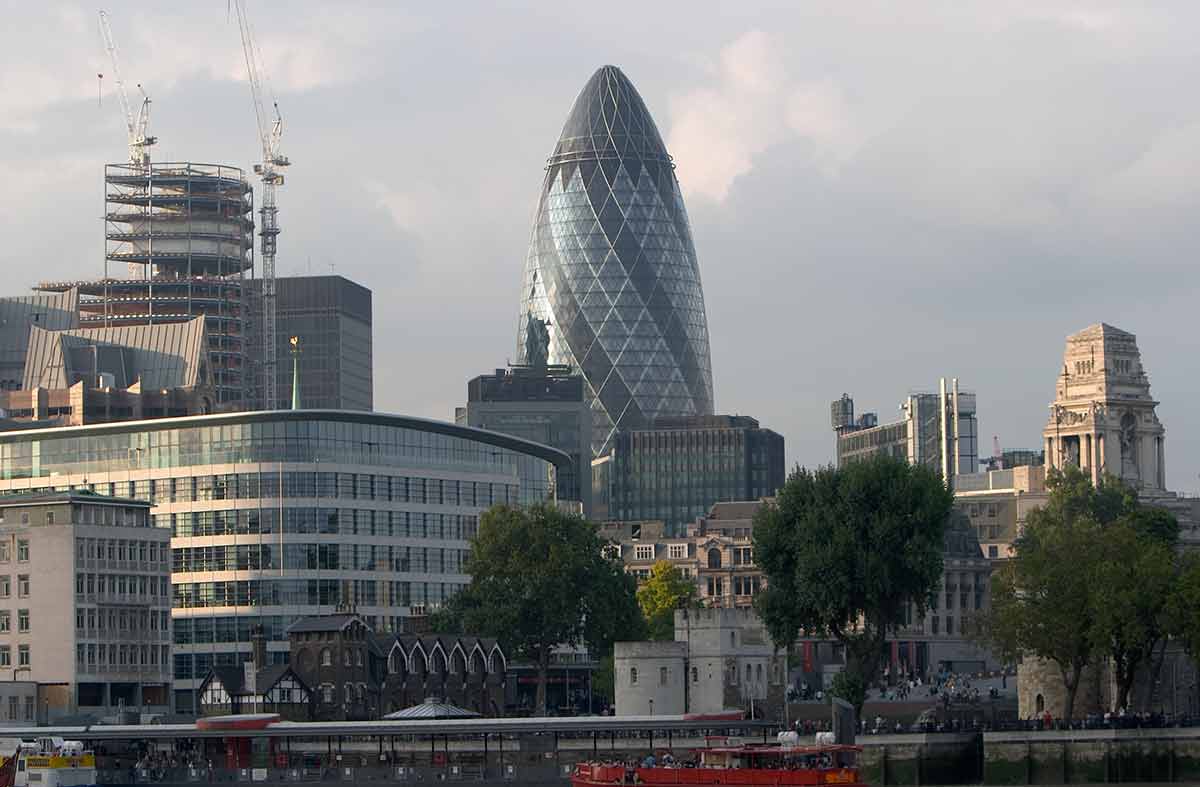
The Gherkin is a distinctive London landmark that is a bullet-shaped glass tower designed by British architect Sir Norman Foster.
The 180 m (591 foot) high futuristic skyscraper has 41 floors and can be seen from all over London.
It took two years to construct and is a gleaming landmark above London’s skyline that is particularly eye-catching after dark.
Except for IRIS Bar, which has 360-degree views of London, and HELIX Restaurant, which is open for lunch and dinner, the rest of the building is not open to the public.
Wandering around London, it’s easy to see why the Gherkin is one of the most iconic buildings in London.
The Gherkin is at 30 St Mary Axe, London and is not open to the public.
28- The Walkie Talkie
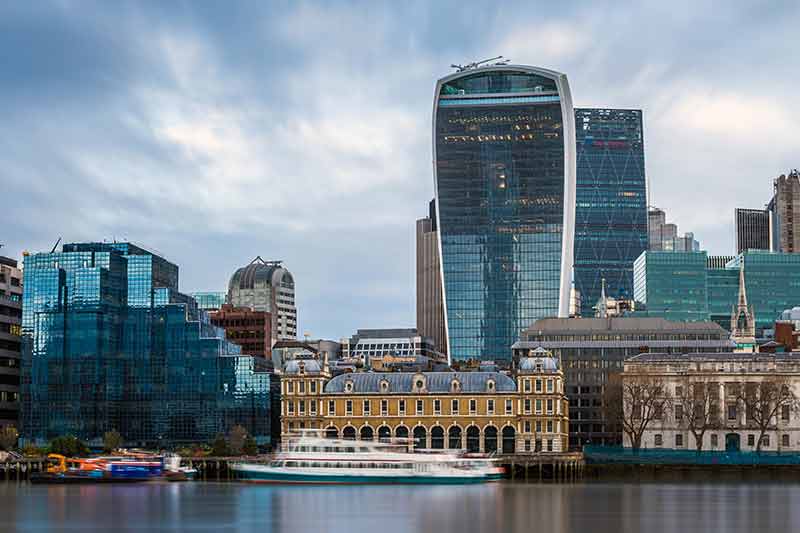
Another London skyscraper with an impressive concave design is shaped like a walkie-talkie.
When it was first built before a sunshade was installed, the glare from the 37-storey mirrored building in London’s financial district was reported to have buckled cars, blistered paint, start fires on a doormat, scorched a lemon and someone even claims to have fried an egg in its rays.
This landmark building in London an eye-catching modern monument.
Sky Garden is a creative tropical garden on the top three floors, with an outdoor terrace and decks to enjoy the view.
Book a table at one of the three restaurants because there are limited tickets to the Walkie Talkie.
The Walkie Talkie is at 20 Fenchurch Street, London.
29- O2 Arena
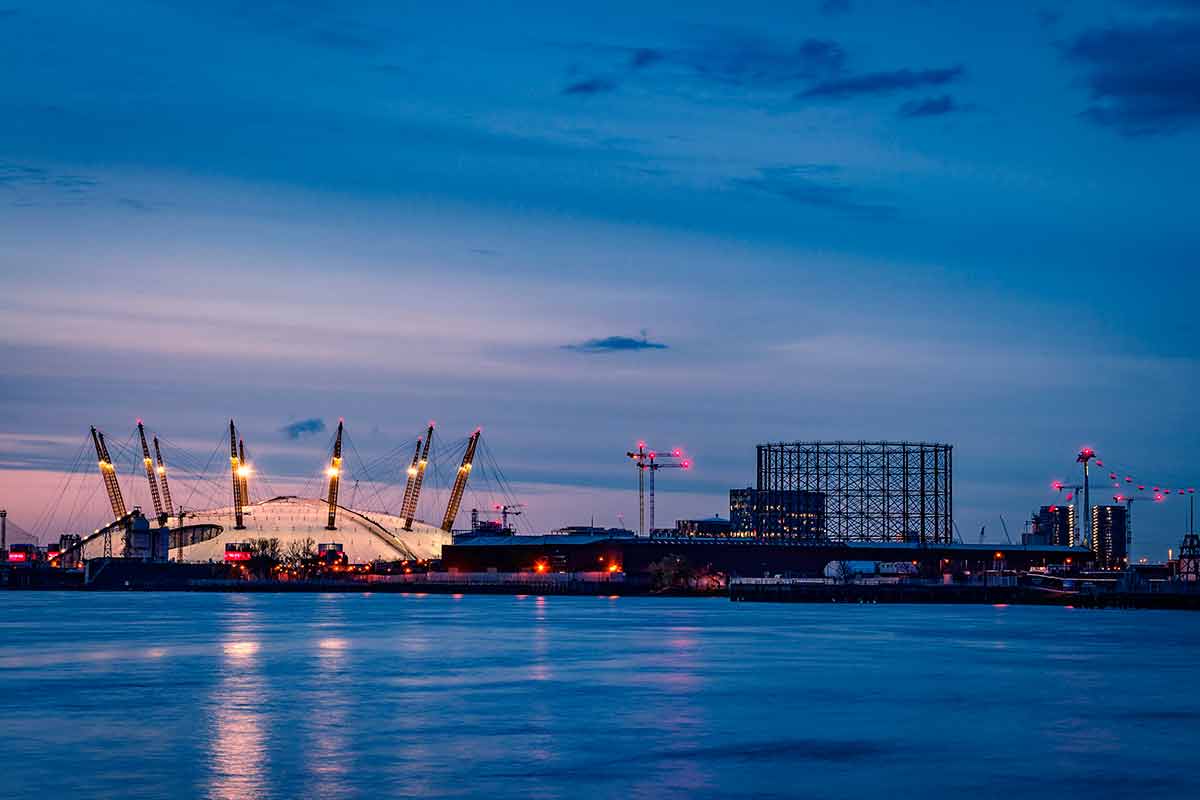
O2 Arena is a contemporary architectural landmark that houses a world-class concert area.
Buy tickets to watch a music concert or a sporting event and soak up the electric atmosphere of the 20,000-strong crowd.
For an adrenalin rush, you can buy tickets to climb the roof.
The O2 Arena is at Peninsula Square, London.
London Landmarks in Southbank
30- Borough Market
“A major supermarket purchased our special dry-cured bacon last week” is the sign at the Sillfield Farm stall.
Although this particular market has occupied its present site for over 250 years, there has been a food market on the south bank of the river for at least 1000 years.
London’s Borough Market is a London icon and visiting the market is quite a treat.
For a tasty sample of contemporary British cuisine prepared with fresh ingredients from the market, book a table at Roast.
London Borough Market is at 8 Southwark St, London. You can enjoy it on a bike tour.
31- London Eye
Get a bird’s-eye view of London – as far as 40km in all directions – from a capsule on the London Eye.
Also known as the Millennium Wheel, the London Eye is a symbol of modern-day London that stands 135m high and was once the world’s tallest observation wheel.
It has since lost its top spot to the Las Vegas High Roller, Singapore Flyer and the Star of Nanchang.
It’s still Europe’s tallest cantilevered observation wheel and is one of the most visited attractions in London.
So, make sure to book the London Eye in advance to avoid standing in a queue for hours. You can jump the queue by booking here.
London Eye is at Lambeth, London.
32- Shakespeare’s Globe
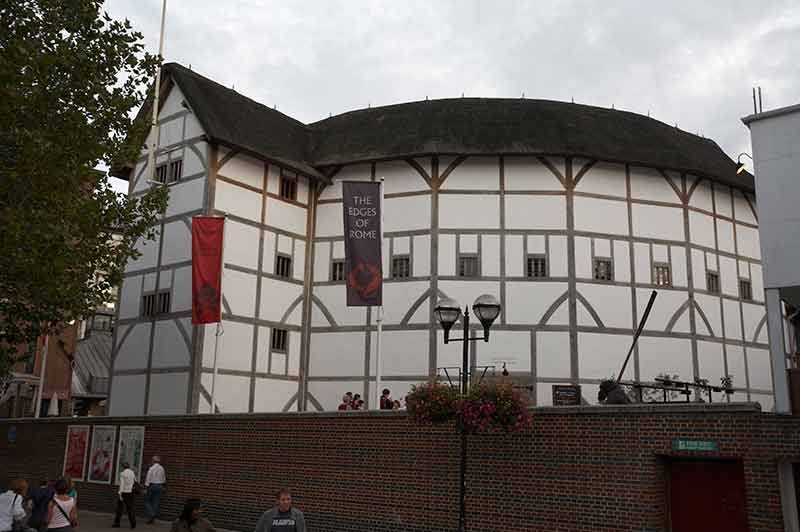
If you fancy a bit of Othello, head to Shakespeare’s Globe Theatre, which is a replica of the 1599 open-air playhouse that performed many of Shakespeare’s plays.
It’s worth taking a guided tour of the theatre, or you can wander through the world’s largest exhibition devoted to Shakespeare.
There is a neat interactive play-reading programme that allows visitors to record their audio performance of a character in a scene alongside pre-recorded readings performed by Globe actors.
There are sword-fighting exhibits, a working printing press and colourful displays of Elizabethan clothing.
33- Southwark Cathedral
London’s first Gothic church has a long and rich history.
Historical highlights include heresy trials held in 1555 during the reign of Mary I, the baptism of John Harvard (founder of Harvard University) and the burial of Shakespeare’s brother, Edmund, in 1607.
In 1996, the cathedral drew the spotlight for hosting the 20th-anniversary service for the Lesbian and Gay Christian Movement.
Inside the cathedral, there’s a large 19th-century stained glass window depicting scenes from Shakespeare’s plays and a statue of a reclining Shakespeare holding a quill.
There’s a memorial to the victims of the Marchioness (the pleasure boat that sank in the Thames river in 1989, killing 51 passengers) disaster and monuments honouring Nelson Mandela and Desmond Tutu.
34- Tate Modern
Created in 2000 from the out-of-commission Bankside Power Station, the Tate Modern is London’s national gallery of international modern art.
All the artworks displayed were created after 1900, including many works by modern British artists.
The gallery is designed around four hubs (Surrealism, Minimalism, post-war abstraction in Europe and the US) and the three linked movements of Cubism, Futurism and Vorticism.
Each hub has exhibits showing the main proponents, predecessors and opponents of the respective movement.
35- Old Operating Theatre, Museum and Herb Garret
Climb the narrow spiral staircase to this musty chamber of horrors. The Old Operating Theatre, Museum and Herb Garret is an unsettling reminder of life before anaesthetics and antiseptic surgery.
After being lost for over a century, the operating theatre was discovered in the garret of St Thomas’s Church in 1956.
The Museum has exhibits of 19th-century medical instruments used by surgeons to amputate limbs, and perform skull operations and childbirth, while the Herb Garret has displays of herbs and potions that would make a witch blush with pride.
The operating theatre was used as a student demonstration arena where underprivileged women were operated on in public. The London Pass will get you in.
In those days, wealthy patients were treated and operated on in their own homes.
- Best Time To Visit England
- 20 Hidden Gems in London
- 20 Famous Landmarks in London
- 20 Famous Landmarks in England
- 20 Famous Landmarks in Ireland
- 21 Famous Landmarks in Wales
- 20 Landmarks In Scotland
- 10 Beautiful Villages in the Cotswolds
- 21 Things To Do In York
- 20 Things To Do In Scarborough
- 20 Best Beaches In Scotland
- 20 Best Beaches In Wales
- 20 Day Trips From London
- 20 Ways To Spend Christmas In London
- 20 Things To Do In London At Night
- 20 Things To Do In Portsmouth
- 20 Things To Do In Exeter
- 20 Things To Do In Gibraltar
- 7 Beaches In Gibraltar
- 20 Things To Do In London In Summer
- 20 Things To Do In Autumn In London
- 20 Things To Do In Winter In London
- 20 Things To Do In Glasgow
- 10 Things To Do In Edinburgh
- 20 Things To Do In The Isle Of Skye
- 15 Things To Do In Derry
- 10 Things To Do In Belfast
- 5 Things to Do In Northern Ireland
- 5 Places To Go Whiskey Tasting In Dublin
- 20 Fairytale Castles In Scotland
- 20 Fairytale Castles In Ireland
- 20 Fairytale Castles In London
- Castles in Great Britain
- The Borough Markets
- Which London Museums Should I Visit?
- The Gore London Review
- 20 Things To Do In Leicester
- 20 Things To Do In Sheffield
- 20 Things To Do In Southampton
- 20 Things To Do In Blackpool
- 20 Things To Do In Ipswich
- 20 British Drinks
- 20 Things To Do In Bath
- 20 Things To Do In Cambridge
- 20 Things To Do In Newcastle
- 20 Things To Do In Leeds
- 20 Things To Do In Norwich
- 20 Things To Do In Brighton
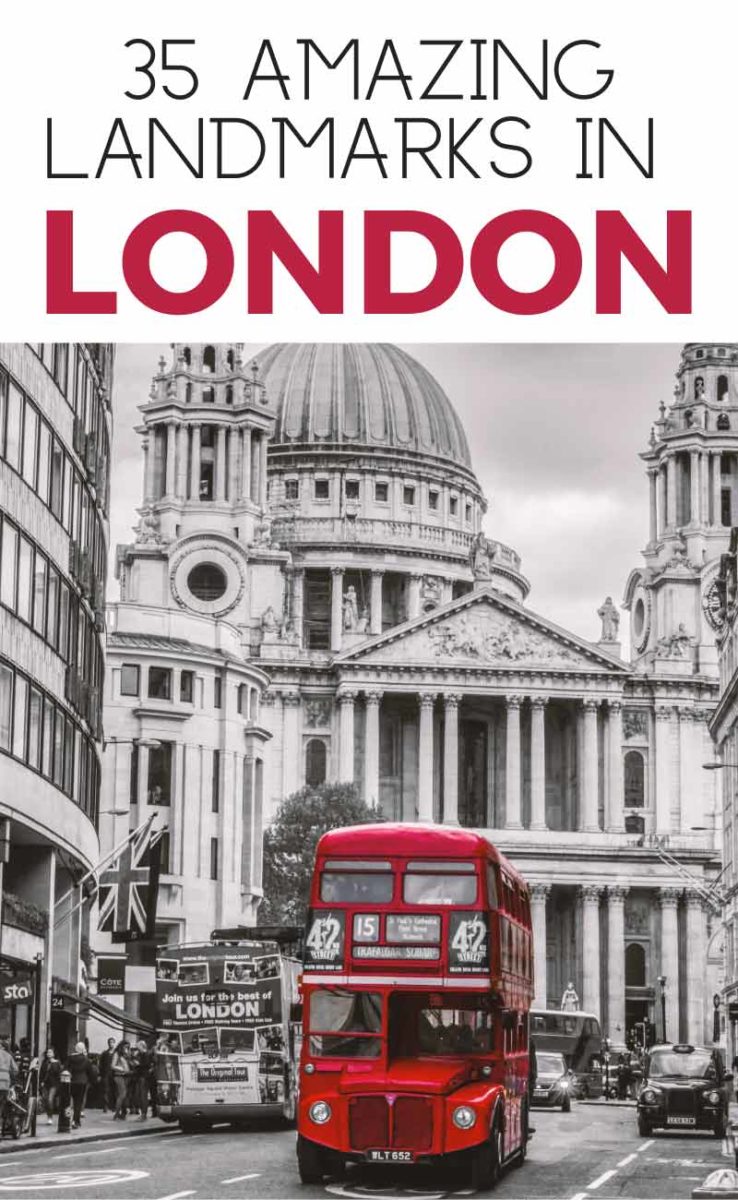
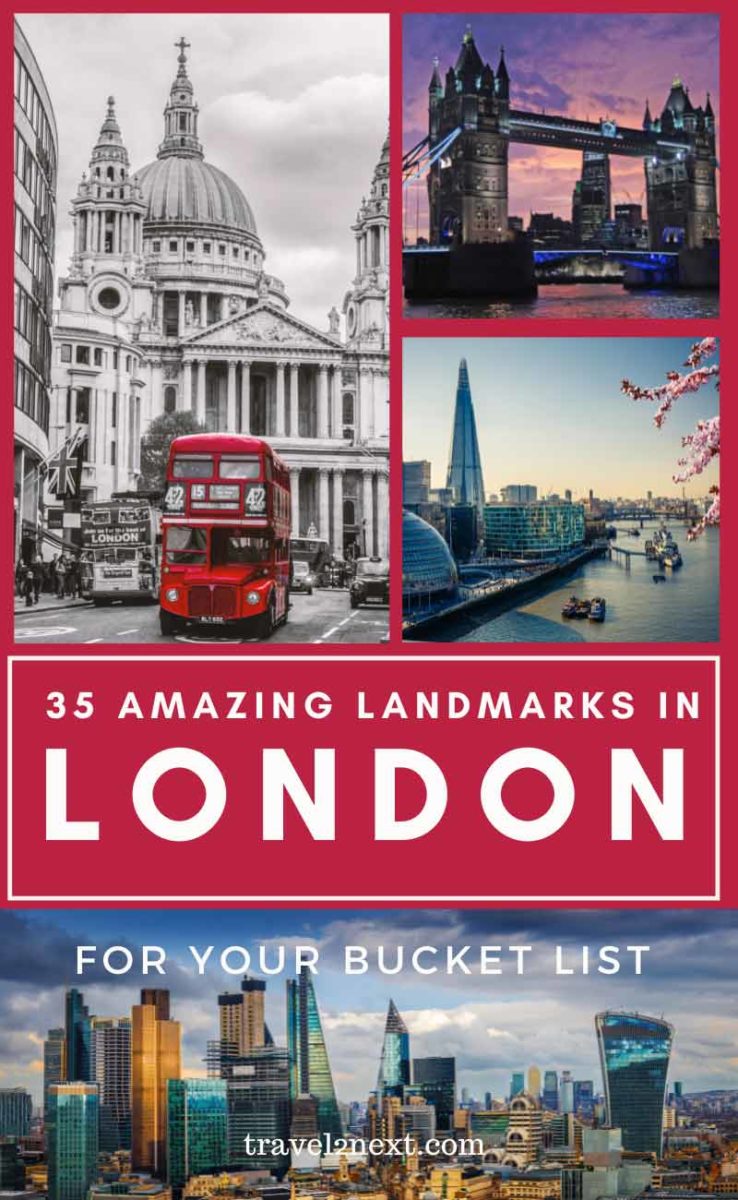
Plan Your Trip

Rent A Car – Find the best car rental rates at Discover Cars. They compare car hire companies to provide you with the best deal right now.

Find A Hotel – If you’re curious about this article and are looking for somewhere to stay, take a look at these amazing hotels.

